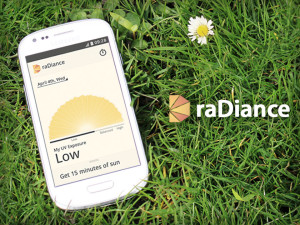
View Case Study
raDiance helps you achieve a better vitamin D balance by beautifully visualising your sun exposure.
When the sun is shining we enjoy the warmth of its radiation and the happiness boost induced from bright sunlight. UVB radiation stimulates the natural production of vitamin D which is critical for good health and disease prevention. Probably best known for promoting stronger bones, vitamin D also boosts your immune system, stimulates brain development, and promotes healthy cardiovascular and muscular function. The most effective way to meet your daily dose of vitamin D is to expose bare skin to sunlight, however too much sun increases risk of skin cancer. raDiance helps answer the question: how much sun exposure do I need? raDiance combines user-input data about skin color, amount of skin exposed, and time in the sun with environmental data including date, time, latitude, altitude, and weather, into an algorithm that estimates a person's UV exposure. This complex information is beautifully displayed in a half disk of sun rays. As a person fills their daily quota for sun exposure, the disk fills with rays and turns from a low blue color to a comfortable orange. Too much sun exposure and the rays turn a burning red. The application also provides a gentle tip for the user to optimise their vitamin D balance. If the person’s UV exposure is low, raDiance recommends the amount of sun the person needs given the day's conditions, while if it is too high, it recommends covering up or wearing sunscreen. If conditions are poor, such as during winter months in northern Europe, raDiance recommends taking a vitamin D supplement. raDiance has been designed for Android. A widget on the home screen displays the user’s current UV levels and will launch the app. The main screen displays the user’s exposure to the sun together with the recommended amount of time for him or her to meet the optimal vitamin D balance. Swiping-up reveals more details about the day's UV conditions and the best time for exposure. To track time in the sun, a user can tap the stopwatch icon in the upper right corner. They will be taken to a user-input screen where they can select their skin color, input their skin exposure, and then initiate a session to track his or her time in the sun. The user can always enter past time spent in the sun by tapping on the “forgot to report” button.
- Why this project is worthy of a UX Award:
raDiance elegantly presents complex health and environmental data, giving people an effortless way to track and optimize their sun exposure. raDiance addresses the negative health effects induced from either extreme of sun exposure: underexposure and the risk of vitamin D deficiency and overexposure and the risk of skin cancer. Worldwide, an estimated 1 billion people suffer from inadequate levels of vitamin D while, on the other spectrum, skin cancer affects between 2 and 3 million people annually and rates of incidence are currently increasing. Through a cheerful and accessible user experience, raDiance provides a highly usable solution to achieve a healthy, balanced level of sun exposure. The user interface design is a simple and seamless process flow. Users can quickly view and understand their daily UV exposure and effortlessly track their time in the sun. One of the main strengths of raDiance is the data visualization of UV exposure. A person’s daily exposure to UV radiation is beautifully displayed in a half disk of sun rays that slowly fills and changes color. Without technical charts or complex graphs, this visualization instantly communicates to the user how much UV radiation they have received and provides visual hints about whether they should get more sun or protect their skin. A drawer of information showing UV levels for the day and location can slide over the data visualization, providing additional information only when queried and simplifying the display of the main visualization. The process of tracking sun exposure is similarly streamlined and fun to use. The user simply starts a session by tapping the stopwatch icon and then playfully enters their skin exposure levels using whimsical pant and shirt sliders. Over time, the application learns a person’s clothing habits to quicken this process even further. raDiance builds on best practices in Android human interface standards to transform complex data and health recommendations into a beautiful and cheerful user experience. It sets a bright tone and encourages people to better manage their sun exposure.
- Submitted By: n/a
See More 2014 Submissions >>